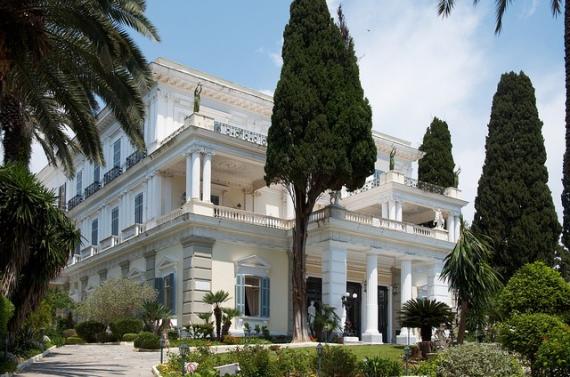Achilleio is undoubtedly one of the most famous royal mansions in Europe, attracting locals and visitors from all over the world.
\rIt was built in 1890 by Empress Elisabeth of Austria (also known as Empress Sisi) and was designed by the Italian architects Karitto Raffaele and Antonio Lannti as a mansion that would help the empress to recover at a time when her health had worsened considerably. \rThe villa was dedicated to Achilles, thus giving the palace its name. It's surrounded by lush gardens with bougainvillea vines in bright colors and towering palm trees. The experienced traveler won't find it difficult to locate the statues representing figures like the "Dying Achilles", an impressive bronze statue of the German sculptor Ernst Cherter. At a height of 11 meters, it shows Achilles trying to pull Paris's arrow out of his heel. This statue was built in 1884 and it's assumed that Elisabeth of Austria bought it after the tragic suicide of her second son, the Archduke Rudolph, in Mayerling. The figure of Achilles is also represented by a second statue that was ordered by Kaiser Wilhelm II, who placed the inscription "To the greatest of the Greeks from the greatest of the Germans."
The palace is located only 9 kilometers east of Corfu Town on a verdant hill. It's a Pompeian-style mansion that was built between 1889 and 1892. A basic feature is the multitude of statues depicting figures of the Greek history and mythology, as well as heroes of Homer's epics. Located in the village of Gastouri, it's hidden among olive groves and the lush nature of the island. Among the impressive statues it features are those of the Olympian gods and the colonnade of the Nine Muses.
The bronze statue of Zeus and Hera adorn the entrance of the Achilleio. Once you enter, among the first things that will amaze you is the portrait of Empress Sisi next to the luxurious fireplace. With a look up to the fresco of the roof, you can see the works of Galoppi, an allegorical portrayal of the "Four Seasons". Also, look out for the Catholic Chapel of Elisabeth as well as her private hall with a collection of personal furniture and objects.
Rare archives, historical documents, family photographs, rare books and souvenirs revive the past of the mansion. In particular, 33 photos of the German Emperor William II and his family members stand out. Among the photographic documents, you can also find one depicting the arrest of the killer of Elisabeth. The museum also hosts typed notes on the organization of the household and handwritten notes on the program of yacht trips. Don't miss the rare books from Elisabeth's collection and the medals from various events of the time. Additional sculptures include 17 copies of ancient works, reflecting Elisabeth's love for the ancient Greek civilization. Among these, try to locate the "Resting Hermes," from the second half of the 19th century. It is said that touching his leg brings luck to the visitor. Also don't forget to spot the bronze replicas of the two "Palaistes- Runners" from the Archaeological Museum of Naples.
It's worth noting that the palace was bought by Kaiser William II in 1907, who significantly changed the internal layout, while the building underwent major damages during the the World Wars. After its restoration, the palace opened as a museum in 1994.







 'Achílleion - Kerkyras / Corfu - Griechenland' - Attribution:
'Achílleion - Kerkyras / Corfu - Griechenland' - Attribution: